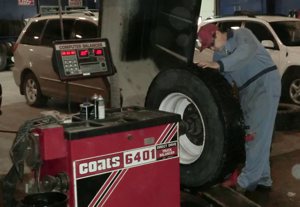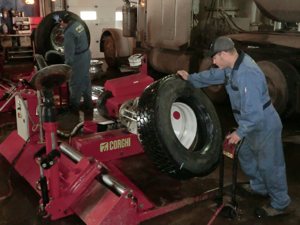Tips
Check balance on steering tires when installing new ones. Balancing tire and wheel assembly helps compensate for both the weight of the tire and wheel after tire is mounted. A wheel is balanced because on a wheel and tire assembly, one area can be heavier or lighter then the rest of the assembly. Improper balance can cause irregular wear, vibration and increase the stress on the front end parts, which may cause them to wear prematurely.

When a wheel and tire assembly is out of balance you will feel a shimmy or vibration in the vehicle starting around 60km/h and can get worse as speed increases. A vibration in your steering wheel could mean improper balance of steering tires. A vibration in the seat or rest of vehicle could mean that other tires are out of balance or are wearing uneven. This can also happen when drive train components and even wheel bearings are lose or worn out.
When replacing drive and trailer tires make sure that the height of the tires on the same axel are even so one tire doesn't wear prematurely before the others on the vehicle. It is also a good idea to have either the same line or same manufacture on the same axel to reduce any unwanted load or stress to the tires casing. Check tires regularly for any uneven wear to help reduce any vibrations that can lead to unwanted wear on other tires or to the vehicle components.
Advanced and unusual wear can reduce the ability of tread to grip the road in adverse conditions. Check your tires for uneven wear, looking for high and low areas or unusually smooth areas. Also look for worn out tires. To check your tread depth of a tire you can use a penny by inserting it into the tread, place the queen's head down, if you can see her crown your tires are worn out and should be replaced.
Properly maintained tires will give you a more comfortable ride and longer tread life. Maintenance tips:
- Clean tires with soap, water and a soft brush or rag.
- Check tires for any cuts, snags, punctures or injury.
- Balance steer tires when they are mounted on wheels.
- Check or have someone else check the torque of the lug nuts after the first 25kms ad make it part of your regular maintenance routine. If premature wear starts, rotating tires can some times slow down or even stop irregular wear.
Alignment generally refers to the adjustment of a vehicle's front and rear suspension parts. Proper alignment ensures that your vehicle handles correctly and will help increase the life and performance of your tires. Wheels become misaligned from hitting potholes, curbs or other road hazards.

Check your air pressure, with a tire gauge, before every trip to ensure there are no tires losing air. Pressure should be checked when tires are cold or at standing temperature. Under inflation results in unnecessary tire stress, irregular wear, loss of control and accidents. A tire can lose up to half its air pressure and not appear to be flat.
Tire pressure drops 1-2 psi every month and with every five-degree drop in temperature.
Lower air pressure does not improve winter traction (the friction between the tires and the road surface affect the amount of grip provided) you want the tire to bite down to the pavement and not float on the snow. Wheels should be torque checked after the first 25 kms after installation and made part of your regular maintenance routine.
To obtain maximum life from your tires it is extremely important to maintain air pressure. Mismatched duals or brands will cause premature wear. We can recommend the best tire and proper application to help you get the lowest cost per Kilometer.
